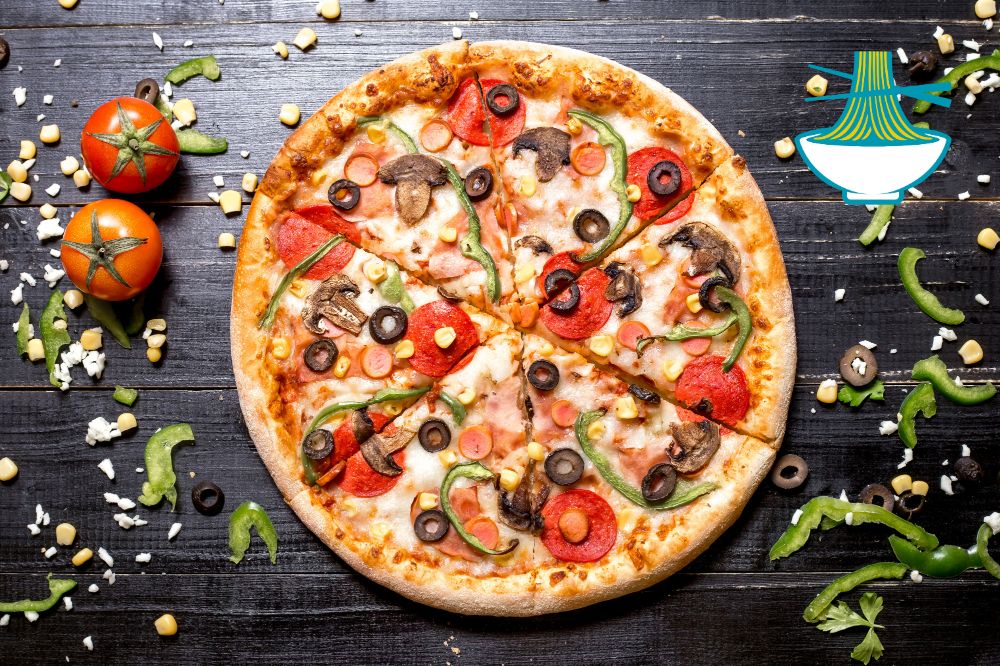Indulge in the culinary masterpiece known as pizza, an Italian gift to the world that transcends borders and tantalizes taste buds. As you explore the rich tapestry of pizza styles, from the iconic Neapolitan to the hearty Sicilian, you'll embark on a journey through the heart and soul of Italy's diverse culinary heritage. Discover the art of crafting the perfect pizza, from kneading the dough to selecting the finest ingredients, and savor the distinct flavors and aromas that make each regional variation a gastronomic delight. Join us in uncovering the secrets of this universally beloved dish, where simplicity meets sophistication and tradition melds with innovation.

Ingredients for a Basic Pizza:
1. Pizza Dough: You can either buy pre-made pizza dough from a store or make your own using flour, water, yeast, salt, and a bit of olive oil.
2. Pizza Sauce: Tomato sauce is the most common base, often seasoned with herbs like basil and oregano. You can also use alternatives like pesto or white sauce.
3. Cheese: Mozzarella cheese is the classic choice. Fresh mozzarella works particularly well for Neapolitan pizza.
4. Toppings: This can vary widely based on personal preference. Common toppings include pepperoni, mushrooms, bell peppers, onions, olives, and more.
5. Olive Oil: Extra-virgin olive oil is often drizzled on top before or after baking.

Preparing a Basic Pizza:
1. Prepare the Dough:
- If making your own dough, combine flour, water, yeast, salt, and olive oil. Knead until you have a smooth, elastic dough, and let it rise for a few hours until it doubles in size.
- Roll out the dough on a floured surface to your desired thickness. A thin crust is traditional for Neapolitan pizza.
2. Preheat the Oven: Preheat your oven to the highest temperature it can go, usually around 500-550°F (260-290°C). A pizza stone or pizza steel can help achieve a crispy crust.
3. Assemble the Pizza:
- Place the rolled-out dough on a pizza peel or a baking sheet dusted with cornmeal or flour to prevent sticking.
- Spread a thin layer of sauce over the dough, leaving a small border for the crust.
- Sprinkle a generous amount of mozzarella cheese over the sauce.
- Add your desired toppings.
4. Bake the Pizza:
- If using a pizza stone or steel, carefully slide the pizza onto the hot surface in the oven.
- Bake for about 10-12 minutes or until the crust is golden brown and the cheese is bubbly and slightly browned.
5. Finish and Serve:
- Remove the pizza from the oven and drizzle with extra-virgin olive oil.
- Optionally, add fresh basil leaves or other herbs for extra flavor.
- Slice the pizza and serve hot.
Distinctive Method for Neapolitan Pizza:
Neapolitan pizza is known for its thin, soft, and slightly chewy crust. It's traditionally cooked in a wood-fired oven at extremely high temperatures. To replicate this distinctive method at home, you'll need:
- A pizza stone or pizza steel to simulate the intense heat.
- A pizza peel for easy transfer.
- A very hot oven (as hot as it can go).
- Minimal toppings. Neapolitan pizza is often topped with just sauce, mozzarella, fresh basil, and a drizzle of olive oil.
The key to Neapolitan pizza is achieving a blistered, charred crust in a short time, typically under 90 seconds in a very hot oven. This requires practice, but it's well worth it if you're a pizza enthusiast.

Nutrition Value
Pizza Dough (per 100 grams):
- Calories: Approximately 250-300 kcal
- Carbohydrates: Approximately 50-60 grams
- Protein: Approximately 7-9 grams
- Fat: Approximately 1-3 grams
- Sodium: Approximately 500-600 mg (varies based on recipe)
Pizza Sauce (per 100 grams):
- Calories: Approximately 20-40 kcal
- Carbohydrates: Approximately 4-8 grams
- Protein: Approximately 1-2 grams
- Fat: Approximately 0-1 gram
- Sodium: Approximately 300-500 mg (varies based on recipe and brand)
Mozzarella Cheese (per 100 grams):
- Calories: Approximately 280-320 kcal
- Carbohydrates: Approximately 1-2 grams
- Protein: Approximately 25-28 grams
- Fat: Approximately 18-21 grams
- Sodium: Approximately 600-700 mg (varies based on brand)
Toppings (varies widely depending on the type and quantity):
- Calories, carbohydrates, protein, fat, and sodium content will vary significantly depending on the toppings used. For example, pepperoni is higher in fat and protein, while vegetables like bell peppers and onions are lower in calories and protein but higher in carbohydrates and fiber.
Olive Oil (per 100 grams):
- Calories: Approximately 800 kcal
- Carbohydrates: Approximately 0 grams
- Protein: Approximately 0 grams
- Fat: Approximately 91 grams
- Sodium: Approximately 2 mg
Please note that these values are approximate and can vary based on factors such as the specific ingredients, portion sizes, and cooking methods used. Additionally, the quantities used for pizza are often smaller than 100 grams for many of these ingredients, so the actual nutritional intake may be less than these values suggest. It's essential to consider portion sizes and dietary requirements when calculating the nutritional content of a specific pizza.

Note
For in-depth insights into Italy's culture, history, and mouthwatering cuisine, simply head over to Wikipedia. There, you'll uncover a treasure trove of information about Italy and its culinary wonders. Enjoy your exploration!


Comments